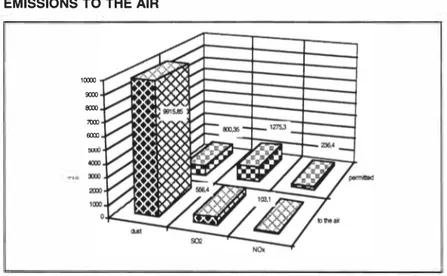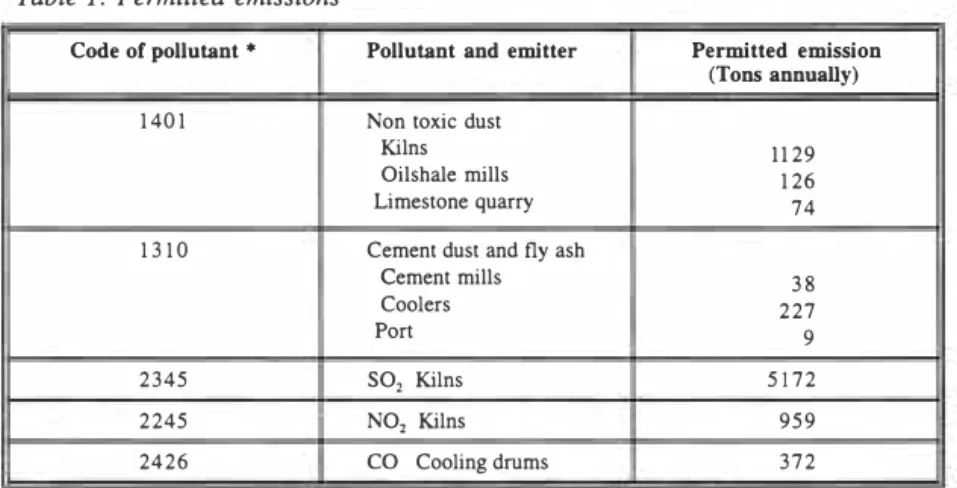WASTE MANAGEMENT AND THE ENVIRONMENT KALMAR, SWEDEN, November 5-7, 1997
22
CEMENT DUST FROM KUNDA
NORDIC CEMENT (KNC) FACTORY
Andres PirsaluEntec AS Estonia
PRESENT SITUATION
The Kunda cement factory is the main polluter in the town of Kunda and in the Liiiine-Virumaa county. The main pollution from the factory is dust. During the renovation of the factory all dust control equipment will be either repaired or re newed.
The cost estimate of the investment program during 1993-1996 is 578 million Estonian kroons (EEK). The costs of all environmental investments during the four year renovation period is estimated to be approximately 125 MEEK (appr. 22% of the total investment sum).
The main dust emitters are rotary kilns. In 1994 the annual dust emission in to the air was 55 233.9 tons, from that 1 472.3 tons was cement dust. During the period of 1995-96 Kunda Nordic Cement Corp. has renovated and installed new effective electric precipitators to 2 rotary kilns. According to the 1997 prognosis these filters catch 45 000 t of clinker dust that present is being transported to the landfill as the dust lacks any field usage. The landfill is heavily over-burdened which in its tum leads to unnecessary extra costs.
WASTE MANAGEMENT AND THE ENVIRONMENT KALMAR, SWEDEN, November 5-7, 1997
EMISSION PROGNOSIS Duat ems11on, tons
70000 8)000 50000 40000 3)000 amou 10000 1 a:>O pnpectve
-
Year 1993 19114 11:195 1'117Fig. 1: Dust emission from kilns 1993 -1997
EMISSIONS TO THE AIR
1996 100)0 9COO ,mi 700) 6000
Fig. 2: Dust and gaseous emissions into the air in the first quarter of 1995
In the first quarter of the year 1995 KNC paid 906 327 EEK pollution tax for emissions. 899 828 EEK for dust emission was paid, 16 499 EEK for gaseous emissions was paid.
74 WASTE MANAGEMENT AND THE ENVIRONMENT
KALMAR. SWEDEN, November 5-7, 1997
AIR PERMIT
Table 1: Permitted emissions
Code of pollutant • Pollutant and emitter Permitted emission (Tons annually) 1401 Non toxic dust
Kilns 1129
Oilshale mills 126
Limestone quarry
1310 Cement dust and fly ash
Cement mills 38 Coolers 227 Port 9 2345 SO, Kilns 5172 2245 NO, Kilns 959 2426
co
Cooling drums 372• Codes of pollutants according to Estonian Pollutant Index
WASTE PERMIT
In January 1996 a new waste permit for the KNC was issued Table 2: Wastes permitted to dump to the Kunda Landfill in 1966
Danger class Code Permitted amounts in tons annually
Construction wastes 5 21503 4,000
Wastes of mineral insulation 4 21508 I
Materials
Asbetos and asbetos dust 4 21510 I
Inert production wastes 5 21705 5,000
Dust from cement kilns 4 21799 40,000
Sediment from sluny basins 4 21804 200
Wastes of tiles containing chrome- 3 31207 800
magnesium compounds
Tires of vehicles 5 37502 I
Ground containing mineral oils 3 34408 25
Total 50,028
Code and danger class of wastes are given according to the Estonian Waste In dex.
WASTE MANAGEMENT AND THE ENVIRONMENT KALMAR, SWEDEN. November 5-7, 1997
LANDFILL DEVELOPMENT
As a result of the reconstruction of the cement factory the ahhual amount of ce ment dust from kilns will arise from 8 000 11 000 tons in 1995 to 46 000 -54 000 tons in 1998. Together with oil-shale dust from the power plant (-25 000 tons) and building material waste with contaminated soil (-37 000 tons) the an nual amount will be approximately 116 000 tons of solid wastes.
Seepage water from the new landfill will be collected together with stormwater of the landfill area and after dilution it will be pumped into the channel collecting stormwater around the landfill site. Presumably the collected seepage water is with a high alkaline reaction and without organic components. If dilution will not prove adequate enough, neutralization should be used.
To prevent pollution due to contaminated water from the old landfill two alter natives have been compared: pumping it into the cement plant for incineration and pumping it into the municipal wastewater system. For incinerating and in termediate water tank (4-5 day storage) is necessary as well as an equipment to pump water into the raw material mills. Everything should be adjusted to meet the technological needs of water. The above said makes this alternative compli cated and expensive. The other alternative is worked out according to the techni cal requirements issued by a company managing the sewage system of Kunda. According to this alternative the leakage water will be collected and pumped into the wastewater system of the town.
USING OF DUST
Due to the installation of the new effective electric precipitators certain changes have taken place in the chemical composition of the caught dust and the relative importance of plant nutrients in the dust has grown. Therefore the matter of pos sible usage of clinker dust as a lime fertilizer and a source of plant nutrients (K, Mg, S, P) has arisen again.
Agricultural scientists have come to the conclusion that in spite of the practice of using Ca-containing fertilizers in Estonia, without lime fertilizers the acid soils balance as to Ca is negative by 120 kg/t, such an amount corresponds to ap proximately 432 kg of clinker dust.
At present it is considered extremely necessary to start regular liming of agri cultural soils, i.e. at least 30 ... 35 000 ha/a.
Liming of acid soils as a process of soils chemical amelioration means a tho rough change in the agro-chemical properties of soil, all this in order to improve its productivity.
Thanks to Estonian research work of international importance, followed by pro motion, extensive liming of acid soils was carried out during 1950-1996. An area of I 839 100 ha was limited. Liming of acid soils was particulary wide-spread during 1966-1989, the annual average limed agricultural area amounting to 63 750 ha.
WASTE MANAGEMENT AND THE ENVIRONMENT KALMAR, SWEDEN, November 5-7, 1997
As agricultural test results from 1950-1996 show the productivity of soil increa sed like this: 1 ton CaCO3 gave 290 food units bigger crops.
In the course of last 5 years the annual limed area has totally amounted only to 4 150 ha, compared to the period of 1966-1989 the figure is 15 times lower.

